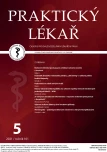Is the public sufficiently aware about the importance of pertussis vaccination in adulthood?
Authors:
P. Macounová; T. Skřížalová; H. Tomášková; R. Maďar
Authors‘ workplace:
Vedoucí: doc. MUDr. Rastislav Maďar, PhD., MBA, FRCPS
; Lékařská fakulta
; Ústav epidemiologie a ochrany veřejného zdraví
; Ostravská univerzita v Ostravě
Published in:
Prakt. Lék. 2021; 101(5): 268-272
Category:
Of different specialties
Overview
Aim. The aim of the survey is to find out what is the awareness of the population in the Czech Republic about the pertussis disease and it’s prevention and to evaluate the factors influencing the level of knowledge. Factors that were monitored are age, education, gender, work or study in health care and pregnancy or motherhood in a child under one year of age.
Methods. An online unstructured questionnaire was created for quantitative data collection. The data were statistically tested, in particular a two-sample t-test for comparing results between the sexes, as well as a logistic regression test, which compared the individual monitored factors, were used. Statistical testing was performed in Stata version 14.
Results. Only less than 12% of respondents showed sufficient knowledge of pertussis prevention (≥ 50% correctness of answers). Work or study in health care was the only statistically significant factor for better knowledge. On the contrary, pregnant women and mothers of children under 1 year of age did not show better awareness, according to the logistic regression test they had 4.9 times worse knowledge than healthcare workers (OR: 4.902482, SE: 2.677679, 95% CI: 1.680736–14.29988).
Conclusion. Given the low knowledge of public, especially pregnant women and mothers of children under 1 year of age about the importance of pertussis vaccination during pregnancy, it would be appropriate to focus on spreading awareness, in which primary care physicians should be involved.
Keywords:
prevention – vaccination – pertussis – whooping cough – cocoon strategy
Sources
1. Fabiánová K, Zavadilová J, Gašpárek M. Pertuse a parapertuse v České republice v roce 2018 – epidemiologická situace (online). Zprávy Centra epidemiologie a mikrobiologie 2019; 28(7): 268–276. Dostupné z: http://www.szu.cz/uploads/Epidemiologie/ Pertuse/Z_CEM_7_2019_Pertuse.pdf [cit. 2021-10-08].
2. Fabiánová K, Zavadilová J, Lenz P, a kol. Pertuse a parapertuse v České republice v roce 2019 – epidemiologická situace (online). Zprávy Centra epidemiologie a mikrobiologie 2020; 29(10): 402–410. Dostupné z: http://www.szu.cz/uploads/Epidemiologie/ Pertuse/402_410_CEM_10_2020_pertuse.pdf [cit. 2021-10-08].
3. Bartošová D. Dětské infekční nemoci. Praha: Galén 2003.
4. Hegerle N, Guiso N. Epidemiology of whooping cough & typing of Bordetella pertussis. Future Microbiol 2013; 8(11): 1391–1403.
5. Chlíbek R. Očkování dospělých. Praha: Mladá fronta 2018.
6. Kline JM, Lewis WD, Smith EA, et al. Pertussis: a reemerging infection (online). Am Fam Physician 2013; 88(8): 507–514. Dostupné z: https://www.aafp.org/afp/2013/1015/afp20131015p507.pdf [cit. 2021-10-08].
7. Nieves DJ, Heininger U. Bordetella pertussis. Microbiol Spectr 2016; 4(3): 311–319.
8. Göpfertová D, Pazdiora P. 100 infekcí: (epidemiologie pro praxi). Praha: Triton 2015.
9. Beneš J. Infekční lékařství. Praha: Galén 2009.
10. Hamplová L. Mikrobiologie, imunologie, epidemiologie, hygiena: pro bakalářské studium a všechny typy zdravotnických škol. Praha: Triton 2015.
11. Cherry JD. Pertussis in young infants throughout the world. Clin Infect Dis 2016; 63(4): 119–122.
12. WHO. Pertussis vaccines: WHO position paper, August 2015 – Recommendations. Vaccine 2016; 34(12): 1423–1425.
13. Clarke M, Thomas N, Giles L, Marshall H. Community awareness and predictors of uptake of pertussis booster vaccine in South Australian adults. Vaccine 2015; 33(51): 7337–7343.
14. Stefanelli P. Pertussis: identification, prevention and control. Adv Exp Med Biol 2019; 1183: 127–136.
15. Ministerstvo zdravotnictví ČR. Vyhláška 306/2012 Sb. o podmínkách předcházení vzniku a šíření infekčních onemocnění a o hygienických požadavcích na provoz zdravotnických zařízení a ústavů sociální péče. Dostupné z: https://www.zakonyprolidi. cz/cs/2012-306 [cit. 2021-10-08].
16. Centers for Disease Control and Prevention. CDC 24/7: Saving lives, protecting people pertussis (whooping cough) (online). Dostupné z: https://www.cdc.gov/pertussis/index.html [cit. 2021- 10-08].
17. Halperin BA, MacDougall D, MacKinnon-Cameron D, et al. Universal tetanus, diphtheria, acellular pertussis (Tdap) vaccination of adults: What the Canadian public knows and wants to know. Vaccine 2015; 33(48): 6840–6848.
18. Donegan K, King B, Bryan P. Safety of pertussis vaccination in pregnant women in UK: observational study. BMJ 2014; 349(111): 4219.
19. Göpfertová D, Pazdiora P, Dáňová J. Epidemiologie: obecná a speciální epidemiologie infekčních nemocí. 2. přepracované vydání. Praha: Karolinum 2013.
20. Donnan EJ, Fielding JE, Rowe SL, et al. A cross sectional survey of attitudes, awareness and uptake of the parental pertussis booster vaccine as part of a cocooning strategy, Victoria, Australia. BMC Public Health 2013; 13(1): 1471–2458.
21. Gabutti G, Azzari C, Bonanni P, et al. Pertussis. Hum Vaccin Immunother 2015; 11(1): 108–117.
22. Ministerstvo zdravotnictví ČR. Zákon č. 372/2011 Sb., o zdravotních službách a podmínkách jejich poskytování (zákon o zdravotních službách) (online). Dostupné z: https://www.zakonyprolidi. cz/cs/2011-372 [cit. 2021-10-08].
Labels
General practitioner for children and adolescents General practitioner for adultsArticle was published in
General Practitioner

2021 Issue 5
Most read in this issue
- Selected risk factors for stroke
- Bloodless clinical strategies for management of severe anaemia and hemorrhage
- Is the public sufficiently aware about the importance of pertussis vaccination in adulthood?
- Acromegaly – under-diagnosed disease with serious complications
